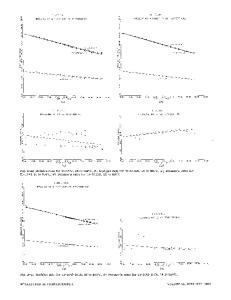Elastic shielding during fatigue-crack growth of titanium matrix composites
- PDF / 613,849 Bytes
- 10 Pages / 612 x 792 pts (letter) Page_size
- 80 Downloads / 367 Views
I.
INTRODUCTION
FIBERS in the longitudinal orientation (0-deg composites) can affect fatigue crack growth (FCG) in two important ways:[1–10] (1) when the fibers bridge the crack, the stresses in the fibers offer resistance to crack opening, thereby drastically reducing the crack growth rate; and (2) under both bridging and nonbridging conditions, load transfer to the higher modulus fibers causes the reduction of the local stress intensity factor (SIF) range at the crack tip, thereby reducing the crack growth rate. The latter load partitioning phenomenon (elastic shielding effect), which is attributable to the presence of a higher modulus material ahead of the crack tip, has not received much attention in the past in addressing crack growth issues in titanium matrix composites (TMCs). Erdogan[11] and Cook and Erdogan[12] have shown through fracture mechanics calculations that the SIF decreases as a crack approaches a higher modulus material. Recently, Larsen et al.[6,7] have discussed the effect of elastic shielding on the FCG rate of SCS-6/Ti-alloy composites. They have shown that elastic shielding factors must be incorporated into crack bridging models to provide more accurate life predictions. However, the effect of the interface on the shielding factor was not addressed. Previous research by the current authors using composites with substantially different interfacial characteristics has demonstrated that interface properties significantly influence the elastic shielding characteristics of a composite system.[13] In this study, the effect of interface properties on elastic shielding and its influence on the FCG rate in TMCs is further investigated using additional experimental results and finite element analysis (FEA). An attempt has been made to quantify the S.G. WARRIER, Research Scientist, and B.S. MAJUMDAR, Senior Scientist, are with UES, Inc., Dayton, OH 45432. This article is based on a presentation made in the symposium ‘‘Fatigue and Creep of Composite Materials’’ presented at the TMS Fall Meeting in Indianapolis, Indiana, September 14–18, 1997, under the auspices of the TMS/ASM Composite Materials Committee. METALLURGICAL AND MATERIALS TRANSACTIONS A
elastic shielding response for different interfaces. The implications of using correct shielding factors on both fiber stress and life predictions are addressed as well. II.
EXPERIMENTAL PROCEDURE
Single-ply composites of SiC fiber–reinforced Ti-6Al-4V composites with four significantly different fiber–matrix interfaces were prepared using standard vacuum hot pressing techniques. Single-ply composites were used because they provide good control over fiber spacing and facilitate accurate monitoring of the position of the crack. The fibers/interfaces selected were uncoated SiC fibers (SCS-0, manufactured by Textron Specialty Materials, Lowell, MA), uncoated SiC fibers (AC-0, manufactured by Amercom, Chattsworth, CA), carbon 1 SiC coated SiC fibers (SCS-6, also manufactured by Textron Specialty Materials), and carbon coated SiC fibers (Trimarc 1, also manu
Data Loading...











